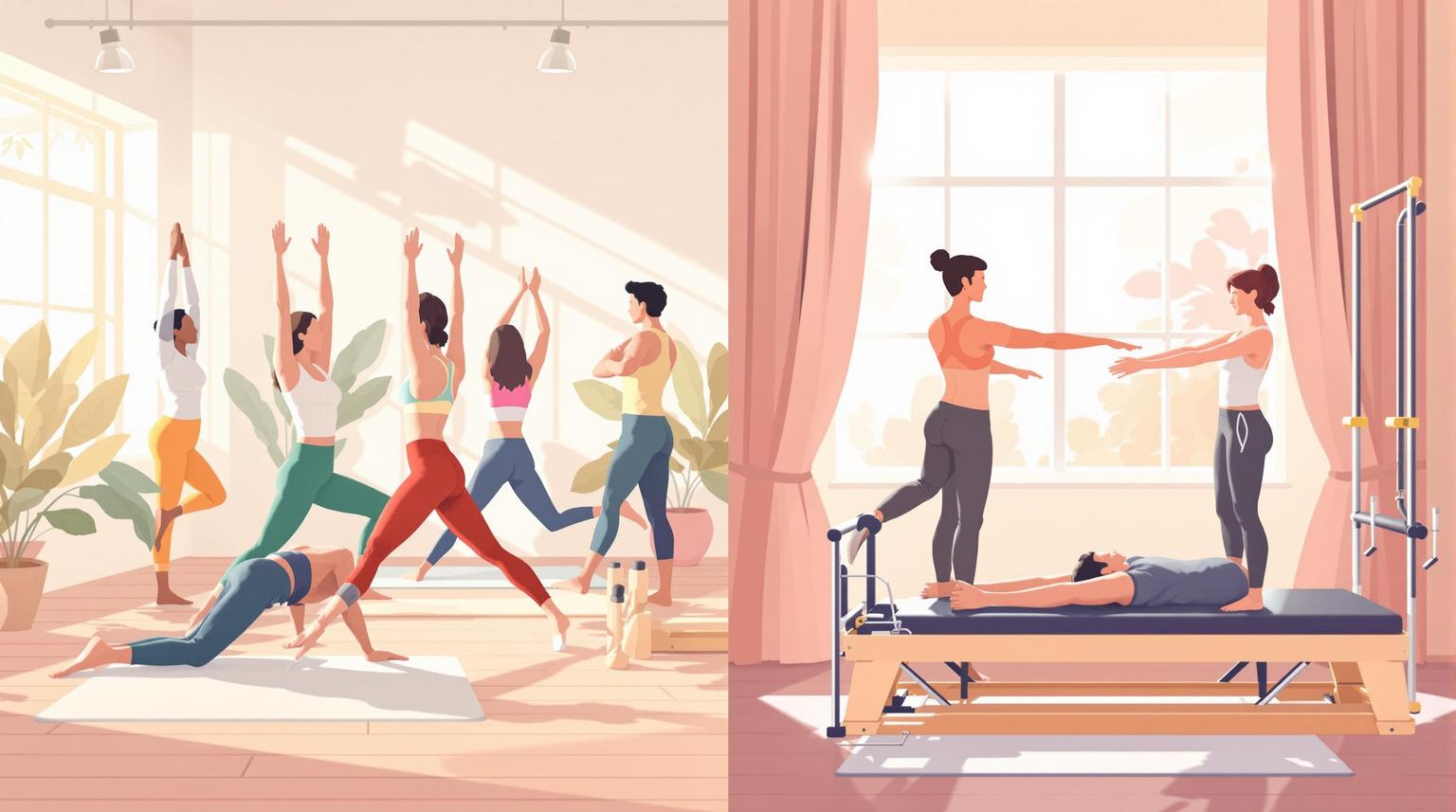Want to improve your posture quickly? Start with these simple steps:
- Do targeted exercises: Try the Cobra Pose, Chin Tucks, and Wall Slides 2-3 times a week to strengthen muscles and improve alignment.
- Set up your workspace: Adjust your screen to eye level, use a chair with lumbar support, and keep your feet flat on the floor.
- Take movement breaks: Move every 30-60 minutes - stretch, walk, or do quick exercises like shoulder rolls.
- Stay mindful: Check your posture regularly and use tools like posture apps or ergonomic supports to stay aligned.
Why it matters: Good posture reduces back pain, improves spine health, and prevents chronic issues. Simple changes to your daily habits and environment can make a big difference. Read on for detailed exercises, workspace tips, and tools to support better posture.
Office Ergonomics: Conquer Sitting Posture with 5 Easy Exercises
Exercises to Improve Posture
Focusing on specific exercises can help retrain muscles and improve alignment, playing a key role in posture correction.
How to Do the Cobra Pose

The Cobra Pose helps strengthen lower back muscles and supports better spinal alignment.
Here’s how to do it:
- Lie face down with your palms flat on the floor beside your shoulders.
- Keep your elbows tucked close to your body.
- Slowly lift your chest off the ground while keeping your hips pressed down.
- Hold the position for 15-20 seconds and breathe normally.
- Lower yourself back down and repeat the movement 10 times.
Chin Tuck Exercise
The Chin Tuck Exercise is effective for addressing forward head posture by strengthening deep neck muscles.
Stand with your back against a wall. Gently draw your chin straight back without tilting your head. Hold the position for 5-10 seconds. Complete 2-3 sets of 10-15 repetitions.
Wall Slide Exercise
This exercise targets rounded shoulders and promotes better spinal alignment. Follow these steps:
- Start Position: Stand with your back flat against a wall and your feet about 6 inches away.
- Arm Position: Bend your elbows at a 90-degree angle, keeping them and your hands in contact with the wall.
- Movement: Slowly slide your arms upward and downward, ensuring they stay in contact with the wall.
- Repetitions: Perform 2-3 sets of 10-15 repetitions.
For the best results, aim to do these exercises 2-3 times a week. If you feel any pain or have existing health conditions, consult a healthcare professional before starting.
Consider tracking your progress by taking photos and noting any changes in how you feel.
While these exercises help build strength, making adjustments to your workspace and daily habits can lead to longer-lasting improvements.
Making Your Environment Posture-Friendly
Creating a workspace that supports your posture can make a big difference in your spinal health. Simple changes to your setup and daily habits can help keep your body aligned and reduce strain.
Setting Up Your Workspace for Better Posture
Your workspace should help you maintain a comfortable, upright posture. Start by placing your monitor at eye level, about 20 inches away, to avoid neck strain and encourage proper alignment. Your desk should be at elbow height, with your keyboard and mouse positioned so your arms can stay relaxed and close to your body. Keep frequently used items within easy reach to minimize unnecessary stretching.
If possible, consider a height-adjustable standing desk. This allows you to switch between sitting and standing throughout the day, which can improve circulation and reduce the stress on your spine.
Sitting and Standing the Right Way
How to Sit Correctly
Make sure your chair is adjusted so your feet rest flat on the floor, and your knees are at or slightly below hip level. A chair with lumbar support is ideal for maintaining the natural curve of your lower back.
Standing Tips
When standing, aim for a neutral body position:
- Keep your ears, shoulders, and hips aligned vertically.
- Engage your core muscles and keep your shoulders relaxed but slightly pulled back.
- Balance your weight evenly between both feet.
If you're using a standing desk, adjust it so your elbows form a 90-degree angle when typing, and your monitor stays at eye level.
Don’t Forget to Move
Staying in one position for too long can lead to muscle fatigue and poor posture. Make it a habit to move every 30-60 minutes. Use these breaks to stretch or take a quick walk to keep your muscles active.
While setting up an ergonomic workspace is a great start, maintaining good posture throughout the day is just as important. Combine a supportive setup with healthy movement habits to keep your spine in shape.
sbb-itb-78deb13
Daily Routines for Better Posture
Maintaining good posture isn't just about setting up a comfortable workspace - it’s about making small, consistent changes to your daily habits. These tweaks can lead to noticeable improvements in how you carry yourself and support your spine.
Taking Regular Movement Breaks
Studies show that taking 5-10 minute breaks every hour can help reduce back pain and improve posture. A simple way to stay on track is to set a timer every 30 minutes as a reminder to stand, stretch, or move around. Use these breaks to do quick exercises like shoulder rolls, neck stretches, or marching in place for half a minute.
Here are a few ideas for movement:
- Shoulder Rolls: Roll your shoulders backward 5-10 times to release tension.
- Neck Stretches: Gently tilt your head from side to side for a light stretch.
- Leg Lifts: March in place for 30 seconds to get your blood flowing.
These short breaks aren’t just about moving - they help you stay mindful of your posture throughout the day.
Staying Aware of Your Posture
Using technology can make it easier to keep your posture in check. A quick self-check is also helpful: ensure your ears, shoulders, and hips are aligned, and keep your feet flat on the floor.
Helpful Tech Tools:
| Tool Type | What It Does |
|---|---|
| Posture Apps | Send reminders to check your alignment. |
| Smart Devices | Track your body position during activities. |
| Timer Apps | Alert you to take movement or posture breaks. |
Engaging Your Core: Lightly pull your belly button inward (without holding your breath) to engage your core. Try this during everyday activities like:
- Using your phone: Hold it at eye level to avoid neck strain.
- Walking: Keep your head up and shoulders back.
- Eating: Sit straight with your feet flat on the floor.
Tools and Expert Help for Posture Support
Posture tools like braces and ergonomic cushions can help align your body and complement daily habits aimed at improving posture. Pairing these tools with professional advice can speed up progress significantly.
Using Posture Braces and Supports
| Support Type | Benefits | Best Used For |
|---|---|---|
| Posture Braces | Helps align spine and shoulders | Sitting or desk work |
| Ergonomic Cushions | Maintains natural spine curve | Office chairs, car seats |
When selecting posture tools, focus on comfort, how well they fit into your routine, and whether they can be adjusted. Start by incorporating them for 15-30 minutes a day to support your posture-improving efforts.
Expert Spine Care
While posture tools are helpful, addressing more complex issues often requires professional input. For ongoing or severe posture challenges, consulting a spine care specialist can uncover root causes and provide personalized solutions.
A spine specialist can:
- Assess your specific posture problems
- Recommend the right supportive devices
- Offer customized correction plans
- Track your progress over time
For improved posture, consider an ergonomic chair with adjustable height, lumbar support, and adaptable armrests. Check out the earlier section on ergonomic workspace setup for more detailed advice on choosing the right chair.
Combining the right tools with expert guidance creates a well-rounded strategy for better posture. This approach builds a solid path toward maintaining healthy alignment over the long term.
Conclusion: Steps to Maintain Good Posture
Improving posture involves a mix of exercises, ergonomic tweaks, and staying mindful of your body’s alignment. Start by assessing how you currently stand or sit, then make small, gradual changes that you can stick to over time.
Key Areas to Focus On
Incorporate exercises like the Cobra Pose, Chin Tucks, and Wall Slides into your daily routine. These moves strengthen the muscles that support good posture and can easily fit into morning stretches or a quick evening session. Beyond exercises, your environment matters just as much.
Set up your workspace to minimize strain. Adjust your screen height, desk, and chair to ensure proper alignment, and use lumbar support to ease pressure on your spine. Once your environment is optimized, the next step is to build habits that help you maintain these improvements.
Making Posture a Habit
Developing good posture habits takes time and consistency. Here’s how to make it stick:
- Stay Mindful: Regularly check your posture while working, walking, or using your phone.
- Practice Regularly: Start with short posture-focused sessions and gradually increase the time as your muscles get stronger.
- Get Expert Advice: If you’re dealing with ongoing issues, consult a specialist for tailored guidance.
Improving posture isn’t an overnight fix. Pay attention to how your body feels during everyday activities, and make small adjustments to stay aligned. By combining exercises, a well-designed workspace, and consistent habits, you’ll build a solid foundation for better posture and a healthier spine.
FAQs
Here are clear answers to some common questions about improving posture.
How can I work on correcting my posture?
Start small and focus on steady progress. Stretching and strengthening exercises are key, especially for muscles that become tight from sitting or standing in one position for too long.
Here are a few tips to get started:
- Check your posture for 5 minutes at intervals throughout the day.
- Set phone reminders for quick exercises like shoulder rolls or chin tucks.
- Dedicate 10-15 minutes daily to core-strengthening exercises.
What are quick ways to improve posture?
You can make progress quickly by adding simple exercises to your daily routine. Try these:
- Child's Pose: Relieves tension in the back.
- Cat-Cow Stretch: Boosts spine flexibility.
- High Plank: Builds core strength.
- Chest Opener: Helps counteract slouching.
- Downward Dog: Stretches and lengthens the spine.
Spend 1-3 minutes on each exercise daily. Combine this with an ergonomic workspace setup and regular movement breaks for the best results.



